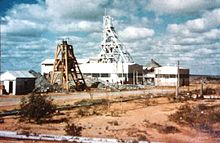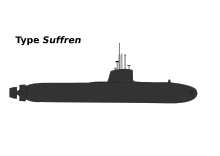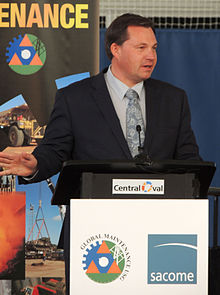Nuclear industry in South Australia
The nuclear industry in South Australia is focused on uranium mining, milling and the export of uranium oxide concentrate for use in the production of nuclear fuel for nuclear power plants. The state is home to the world's largest known single deposit of uranium, which is worked by BHP at the Olympic Dam mine.
Contaminated legacy sites exist at
In 2017, a site near Kimba on Eyre Peninsula was selected for Australia's national radioactive waste management facility, where domestically-generated nuclear waste would be stored. Construction was planned for late 2022. Selection of this site has generated an environmental conflict, because the Barngarla people who claim the site as their traditional land were not consulted or included in the vote approving the facility.[1] Barngarla elders have raised legal challenges to the site selection.[2][3]
Advocates for an expanded nuclear industry in South Australia have included former Prime Ministers from both Labor and Liberal parties.
Uranium mining

Exploration for uranium in South Australia reached a record high in 2006 with forty companies exploring for the mineral.[6]
Uranium export
Uranium mined in South Australia is exported, where it is used in the production of nuclear fuel for use in nuclear power plants. In 2013, uranium oxide concentrate produced in South Australia was being exported to Britain, France, Sweden, Finland, Belgium, Canada and the United States.
Nuclear waste storage


Concentrations of nuclear waste in South Australia exist in the tailings ponds at the Olympic Dam mine, at the site of the former Port Pirie uranium treatment works and in the tailings block at the former Radium Hill mine. The CSIRO operates a nuclear waste storage facility at Woomera in the state's far north. Studies and debates about where to store Australia's radioactive waste have been ongoing since the 1980s.[1]
The Howard government made unsuccessful attempts to establish nuclear waste storage facilities in South Australia between 1998 and 2004.[10] This proposition was revived during the LNP coalition Abbott, Turnbull, and Morrison governments from 2013-2022. Various sites on Aboriginal lands proposed between 1998 and 2016 have been contested by Indigenous people and denounced as forms of environmental racism.[11]
Recommendations by the Nuclear Fuel Cycle Royal Commission in 2016 ultimately resulted in a site selection near Kimba on Eyre Peninsula.
National Radioactive Waste Management Facility
The Kimba site has been contested by Barngarla people who claim the site as their traditional land and were not consulted or included in the vote approving the facility.[1] Barngarla elders have raised legal challenges to the site selection.[2][3]
A seven year-long consultation process preceded the official selection of a site at Napandee, near Kimba in South Australia for a future National Radioactive Waste Management Facility.[citation needed]
Prospective sites were voluntarily nominated by their owners,
The Kimba sites are located in the federal electorate of Grey, for which Rowan Ramsey is the sitting member. Ramsey publicly advocated for the establishment of nuclear waste storage facilities in South Australia, and has stated that he would be comfortable storing it on his own property.[15] Ramsay did not nominate his own property for the project after receiving advice that it would constitute a conflict of interest. Opinion on the benefits and risks associated with establishing a facility has divided the township of Kimba.[16]
Opponents of the establishment of a new national facility for domestically produced nuclear waste believe that such waste should be stored long-term at Lucas Heights, where much of the waste was and continues to be generated. Spokespeople for the opposition include Jim Green of Friends of the Earth and David Sweeney of the Australian Conservation Foundation.[17]
Prospective deep geological storage
Spent nuclear fuel is considered to be high-level nuclear waste, and requires isolation from the environment, ideally in a facility deep underground. The prospect of storing nuclear waste in the underground tunnels of the Olympic Dam mine has been speculated upon by opinion writers, politicians and the community.[18]
Support for the development of new nuclear waste storage facilities in South Australia was expressed by the Committee for Adelaide on 6 May 2016.[19]
The Nuclear Fuel Cycle Royal Commission's final report, which was delivered to the Governor of South Australia on 6 May 2016 recommended the consideration of the establishment of a repository for imported spent nuclear fuel in South Australia. That would require deep, underground storage to isolate the waste from the environment. The report was released in full on 9 May 2016.
The report was put before a Citizens Jury, which ultimately voted not to proceed with investigating the prospect of importing spent nuclear fuel for storage and disposal in South Australia. In December 2016, a group of prominent citizens signed an open letter expressing an opposing view. It stated:
"We, the undersigned, call on South Australia’s elected representatives of all parties to continue to explore this opportunity. We request further investigations into issues that a) are essential for better understanding project feasibility and b) could be investigated at relatively low cost. We call for partnership between the State Government and relevant Federal Government agencies to formally meet with prospective client nations in order to gain greater certainty and ensure we are fully informed as to the nature of this opportunity."
Signatories were:
A similar letter was published in March 2017 on
In March 2017, it was estimated that $30 million would need to be spent to manage nuclear waste stored at Woomera. Barrels containing the wastes were found to be rusting and deteriorating.[23]
Nuclear submarines

In 2021, the Morrison government announced that Australia would acquire a fleet of nuclear-propelled submarines, replacing a prior agreement with French contractor
The prospect of constructing nuclear submarines in South Australia had been raised on various occasions during the 2010s. In 2011, the CEO of Defence SA, Andrew Fletcher expressed his personal view that it would be unlikely for Australia's Future Submarine project to commit to producing nuclear powered submarines, unless a nuclear industry was established in Australia beforehand, or if their production was outsourced offshore. He expressed his belief that a commitment to 12 diesel-powered submarines was more likely.[24] Authors from UCL Australia have written opinion pieces and produced research papers on the topic. In 2015, former Rolls-Royce nuclear engineer and submarine expert Steve Ludlam was appointed to the Defence SA Advisory Board.
In 2016, the contract for the supply of Australia's Future Submarines Project was awarded to French company
in 2017, former Australian Prime Minister Tony Abbott spoke of the merits of considering nuclear propulsion for Australia's Future Submarine Project, claiming various advantages over diesel propulsion, including range and speed.[26]
In 2021, the AUKUS security pact was signed as a trilateral agreement between Australia, the USA and the UK. The agreement with the French was abandoned, in favour of developing a fleet of nuclear-powered submarines with American and British technology and expertise. The new, nuclear fleet will be designed and developed in collaboration with AUKUS partners with further details expected to be announced in 2023.
Nuclear weapons
A series of British nuclear weapons tests were conducted at Maralinga and Emu Field during the 1950s and early 1960s. Land remains contaminated at these sites and access is restricted.
Australia has no domestic nuclear weapons nor the capability to develop them. Australia is allied with countries which do maintain nuclear arsenals. As of 2016 the
Potential expansion
In 2015, a Nuclear Fuel Cycle Royal Commission was initiated by the Government of South Australia. It was tasked with investigating opportunities and risks associated with potential expansion of the state's role in the nuclear fuel cycle. Commissioner Kevin Scarce delivered its final report to the Governor of South Australia on 6 May 2016. The Commission's final report recommended the repeal of prohibitions preventing nuclear industrial development in Australia, including the legalisation of nuclear power generation. The report recommended the establishment of a facility to store international stockpiled spent nuclear fuel and the consideration of a nuclear fuel leasing scheme to accompany it. The latter was also described by the Commission as a potential enabler for future enrichment and fuel processing activities, though such further processing developments were deemed to not be feasible within the next decade. The establishment of nuclear power generation in South Australia was also deemed inappropriate given the state's high penetration of solar and wind power.
2016–17
The Government of South Australia allocated $3.6 million to the Department of the Premier and Cabinet for 2016–17 "to enable the government to engage with the community to develop an informed response to the Nuclear Fuel Cycle Royal Commission Final Report."[28]
Citizens' Jury process

Following the conclusion of the Nuclear Fuel Cycle Royal Commission, the Department of the Premier and Cabinet established a "YourSAy nuclear?" website, advertising campaign and Citizens' Jury process. Managed by the New Democracy Foundation, the Citizens' Jury process randomly invited 25,000 South Australians to participate by post. Of those who accepted the invitation, a total of 350 jurors will be chosen to meet and discuss the Nuclear Fuel Cycle Royal Commission's final report, help produce a simplified version for further discussion, and ultimately express their support or rejection of its various recommendations. South Australian company DemocracyCo won the contract to facilitate the first Citizens' Jury. DemocracyCo spokesperson Emily Jenke described the process and its result as "one of the pieces the Premier and Government will be using to inform their thinking".[29]
The first Citizens' Jury was composed of 50 people. They were provided with the Nuclear Fuel Cycle Royal Commission's final report and heard from a panel whose members are listed below.[30]
| Member's Name | Primary Position Held | Other Relevant Affiliations |
|---|---|---|
| Jason Kuchel | CEO of South Australian Chamber of Mines & Energy | Member of Minerals and Energy Advisory Council |
| Simon Longstaff | Founder of The Ethics Centre | Financial supporters of The Ethics Centre include BHP and Santos[31] |
| Nigel McBride | CEO of Business SA
|
Member of the State Advisory Council of the Committee for Economic Development of Australia (CEDA), former lawyer with MinterEllison |
| Michael Penniment | Director of Radiation oncology at the Royal Adelaide Hospital
|
Employee of the Government of South Australia |
| Leanna Read | Chief Scientist of SA | Member of Australian Academy of Technological Sciences and Engineering and Chair of the South Australian Science Council
|
| Kelly-Anne Saffin | CEO of Northern and Yorke Regional Development Australia | RDA is funded by the Government of Australia and the Government of South Australia[32]
|
| Keith Thomas | CEO of SA Native Title Services | SA Native Title Services is funded by the Government of South Australia[33] |
| Craig Wilkins | CEO of Conservation Council of South Australia | Wilkins is former Chief of Staff of Australian Greens MLC Mark Parnell. The Conservation Council of South Australia receives funding from the Government of South Australia. |

The first Citizens Jury produced a report after hearing witnesses and deliberating over four sitting days. Its publication was followed by the launch of a statewide community consultation program coordinated by the Department of the Premier and Cabinet. The campaign carried the slogan "Get to know nuclear. Discover. Discuss. Decide" and included print, radio and television commercials, online discussions and community displays attended by DPC staff.
A second jury was later formed, expanding the cohort of jurors to approximately 350 people.
After hearing from a larger cohort of expert witnesses, the citizens' jury ultimately concluded, by a two-thirds majority vote, to not pursue to prospect of the importation of spent nuclear fuel to South Australia under any circumstances. A "lack of trust" was cited as a primary driver.[34]

Support
Support for expanding the nuclear industry in South Australia has been expressed by corporate uranium mining interests
In March 2017, eleven members of the
Opposition
There has been considerable Australian resistance to
Opponents to the expansion of nuclear industry in South Australia include the Australian Greens (whose spokespeople include Scott Ludlam and Mark Parnell), Friends of the Earth, the Australian Conservation Foundation and the Conservation Council of South Australia. Opposition has also been expressed by Kevin Buzzacott, Eileen Kampakuta Brown, Eileen Wani Wingfield and other elders of several indigenous peoples. The Desert Liberation Front has coordinated protest events at the gates of the Olympic Dam mine in 2012 and 2016 using the names The Lizard's Revenge and The Lizard Bites Back.[40]
See also
- Kupa Piti Kungka Tjuta (1995-2004 anti-nuclear waste campaign in Coober Pedy)
References
- ^ ISSN 0261-3077. Retrieved 4 February 2023.
- ^ a b "Earthworks approved for nuclear waste dump despite opposition from traditional owners, court hears". the Guardian. Australian Associated Press. 15 June 2022. Retrieved 24 January 2023.
- ^ a b "National Radioactive Waste Management Facility - Radioactive waste". Australian Radiation Protection and Nuclear Safety Agency. Retrieved 24 January 2022.
- Canberra Times5 November 1988
- ^ "Mines and quarries". minerals.statedevelopment.sa.gov.au. Retrieved 6 May 2016.
- ^ "20 Years of MESA Journal" (PDF). MESA Journal 80 – 1. Government of South Australia. p. 6. Retrieved 27 June 2016.
- ^ Adelaide Advertiser. Retrieved 4 July 2016.
- ^ "SA Premier supports uranium export to India". 15 November 2011. Retrieved 4 July 2016.
- ^ "Australia Ready For Uranium Sales To India". Huffington Post Australia. Retrieved 4 July 2016.
- ^ "A timeline of South Australia's nuclear dump debate". ABC News. 22 September 2015. Retrieved 6 May 2016.
- ^ "Radioactive waste and the nuclear war on Australia's Aboriginal people". theecologist.org. Retrieved 4 February 2023.
- ^ "National Radioactive Waste Management Facility". radioactivewaste.gov.au. Retrieved 3 September 2017.
- ^ "Six sites shortlisted for nuclear waste storage facility". ABC News. 12 November 2015. Retrieved 6 May 2016.
- ^ "SA cattle station could be first nuclear waste dump site". ABC News. 28 April 2016. Retrieved 6 May 2016.
- ^ "Lib MP happy to store nuclear waste". News.com.au. Retrieved 3 September 2017.
- ^ "Kimba community divided over proposed nuclear dump". ABC Rural. 18 February 2016. Retrieved 3 September 2017.
- ^ "Kimba votes yes to radioactive waste dump". Retrieved 3 September 2017.
- ^ "160616 – Ramsey visits ahead of 'important' Election". themonitor.com.au. Retrieved 17 June 2016.
- ^ "Finland nuke trip convinces delegation to support SA waste dump plan". ABC News. 6 May 2016. Retrieved 7 May 2016.
- ^ "Advocates want waste talk to continue". ohscareer.com.au. Retrieved 29 September 2017.
- ^ "Dear SA, don't dump nuclear option". Retrieved 29 September 2017.
- ^ "An open letter to South Australia's elected members and political parties 2 March 2017". Bright New World. Retrieved 29 September 2017.
- ^ Jean, Peter (14 March 2017). "Deteriorating radioactive waste barrels at Woomera require $30 million clean-up by CSIRO". The Advertiser. Retrieved 3 September 2017.
- ^ "From The Source: Andrew Fletcher Chief Executive Officer of Defence SA". Retrieved 3 August 2016.
- ^ "Coalition plans nuclear-powered submarine fleet over long term". Australian Financial Review. 1 May 2016. Retrieved 18 June 2016.
- ^ a b "TRANSCRIPT. The Hon Tony Abbot MP, Submarines: why settle for second-best?". cis.org.au. Retrieved 30 June 2017.
- ^ "Barack Obama makes history in Hiroshima, while Australia stops worrying and loves the bomb". Retrieved 4 July 2016.
- ISSN 1440-8589.
- ^ "Nuclear jury about the big picture, not manufacturing consent – InDaily". InDaily. 3 June 2016. Retrieved 17 June 2016.
- ^ "A businessman, an environmentalist and an oncologist walked into a citizens' jury... – InDaily". InDaily. 23 June 2016. Retrieved 23 June 2016.
- ^ "The Ethics Centre – The Ethics Centre". ethics.org.au. Retrieved 23 June 2016.
- ^ North, Regional Development Australia Yorke and Mid. "Regional Development Yorke and Mid North – Role & Structure". Regional Development Australia Yorke and Mid North. Retrieved 23 June 2016.
- ^ "Overview". nativetitlesa.org. Retrieved 23 June 2016.
- ^ "'No decision' on nuclear waste plan: Weatherill". Retrieved 30 June 2017.
- ^ "Submission to the Royal Commission into the Nuclear Fuel Cycle" (PDF). BHP Billiton. 8 March 2015. Retrieved 7 May 2016.
- Sydney Morning Herald. Retrieved 7 May 2016.
- ^ "Nuclear waste dump could earn SA billions of dollars: Switkowski". ABC News. 16 February 2015. Retrieved 7 May 2016.
- ^ Massola, James; Gartrell, Adam (15 March 2017). "Put nuclear in the energy mix, Coalition MPs tell Malcolm Turnbull". The Sydney Morning Herald. Retrieved 3 September 2017.
- ^ Marty Branagan. The Australian Movement against Uranium Mining: Its Rationale and Evolution, International Journal of Rural Law and policy, 2014.
- ^ Jones, Erin (3 July 2016). "SA Police close Olympic Way as anti-uranium protesters light bonfire in the middle of the road". The Advertiser. Retrieved 3 July 2016.
